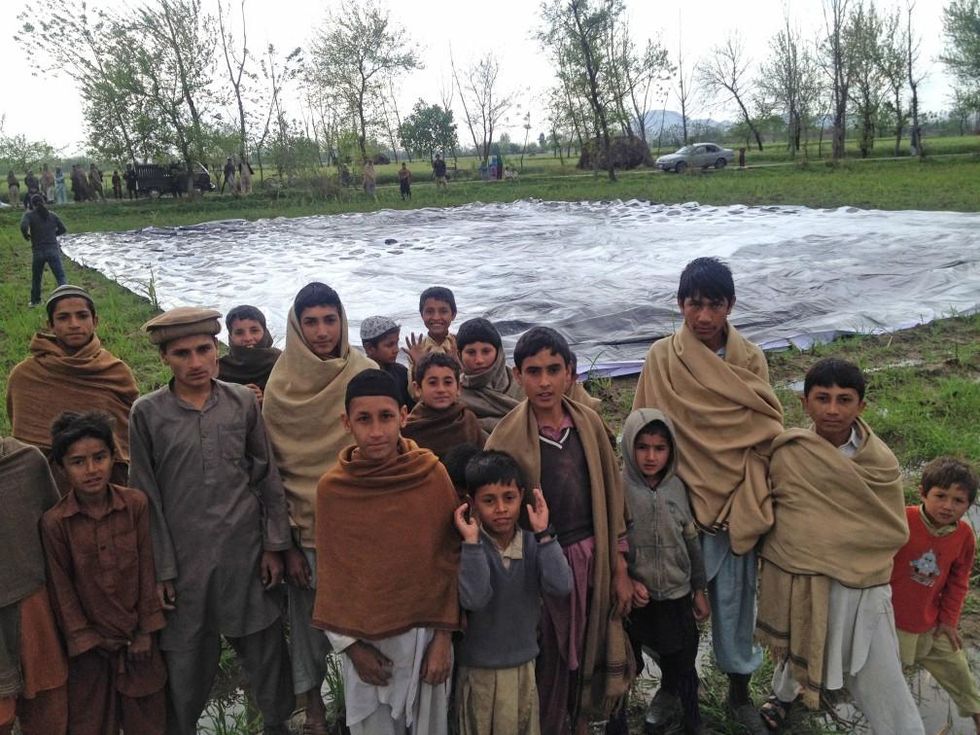#NotaBugSplat: Artists Use Enormous Portrait to Humanize Victims of US Drones
'When viewed by a drone camera, what an operator sees on his screen is not an anonymous dot on the landscape, but an innocent child victim’s face.'
In an attempt to humanize the many hundreds of innocent people killed by U.S. drone attacks in Pakistan, an artist collective has teamed up with human rights advocates and local villagers to turn the tables on the drone operatives themselves by "targeting" them with something they rarely see from their military control rooms half-way around the world: the face of one of their potentially innocent victims.
Tired of seeing the innocent men, women, and children of U.S. drone attacks termed "bug splats," the French-based project is being done as a collaborative effort between artists and two human rights group, the UK-based Reprieve and the Foundation for Fundamental Rights in Pakistan, and was launched with the hashtag-friendly name, #NotaBugSplat.
According to the group's website:
In military slang, Predator drone operators often refer to kills as 'bug splats', since viewing the body through a grainy video image gives the sense of an insect being crushed.
To challenge this insensitivity as well as raise awareness of civilian casualties, an artist collective installed a massive portrait facing up in the heavily bombed Khyber Pukhtoonkhwa region of Pakistan, where drone attacks regularly occur. Now, when viewed by a drone camera, what an operator sees on his screen is not an anonymous dot on the landscape, but an innocent child victim's face.
The child featured in the poster is nameless, but says the group, the young girl lost both her parents and two young siblings in a U.S. drone attack.

Sakib Afridi, a spokesperson for the group, explained to Channel 4 News: "We've been working on this for a few months. About a month ago we put it together and about two weeks ago we installed it in Pakistan."
The girl, explained Afridi, is "an image of innocence like most children in that area."
The project received little attention at first, but has now picked up momentum as various outlets have picked up the story.
From The Guardian's coverage:
The number of civilians so far killed by drones remains a matter of intense debate, but the worry among campaigners is that this kind of warfare makes killing unpleasantly easy. Operators have compared the experience with playing a computer game, and a Rolling Stone article in 2012 recorded their use of the term "bug splat" to describe the mess on the ground that killing someone leaves behind. [...]
The intenion now is that any drone operator who looks down through their camera and sees this village will have reason to think twice. In their own words, the artists hope the image "will create empathy and introspection amongst drone operators, and will create dialogue amongst policy makers, eventually leading to decisions that will save innocent lives".
Channel 4 adds:
The Bureau of Investigative Journalism has been investigating US drone activity in Pakistan, Yemen and Somalia. It estimates that since 2004, up to 3,700 people have been killed as a result of CIA drone strikes in Pakistan, and that up to 957 of them were civilians.
The CIA has reportedly not carried out a strike in Pakistan since the start of the year.
In 2012, an investigation by Channel 4 News found women and children living in a state of panic and fear due to the threat of drone strikes.
Those findings were echoed by academics from Stanford Law School and New York University's School of Law who found the aircraft "terrorise" men, women and children "24-hours a day" causing "substantial levels of fear and stress".
And on Twitter:
_______________________________________
An Urgent Message From Our Co-Founder
Dear Common Dreams reader, The U.S. is on a fast track to authoritarianism like nothing I've ever seen. Meanwhile, corporate news outlets are utterly capitulating to Trump, twisting their coverage to avoid drawing his ire while lining up to stuff cash in his pockets. That's why I believe that Common Dreams is doing the best and most consequential reporting that we've ever done. Our small but mighty team is a progressive reporting powerhouse, covering the news every day that the corporate media never will. Our mission has always been simple: To inform. To inspire. And to ignite change for the common good. Now here's the key piece that I want all our readers to understand: None of this would be possible without your financial support. That's not just some fundraising cliche. It's the absolute and literal truth. We don't accept corporate advertising and never will. We don't have a paywall because we don't think people should be blocked from critical news based on their ability to pay. Everything we do is funded by the donations of readers like you. Will you donate now to help power the nonprofit, independent reporting of Common Dreams? Thank you for being a vital member of our community. Together, we can keep independent journalism alive when it’s needed most. - Craig Brown, Co-founder |
In an attempt to humanize the many hundreds of innocent people killed by U.S. drone attacks in Pakistan, an artist collective has teamed up with human rights advocates and local villagers to turn the tables on the drone operatives themselves by "targeting" them with something they rarely see from their military control rooms half-way around the world: the face of one of their potentially innocent victims.
Tired of seeing the innocent men, women, and children of U.S. drone attacks termed "bug splats," the French-based project is being done as a collaborative effort between artists and two human rights group, the UK-based Reprieve and the Foundation for Fundamental Rights in Pakistan, and was launched with the hashtag-friendly name, #NotaBugSplat.
According to the group's website:
In military slang, Predator drone operators often refer to kills as 'bug splats', since viewing the body through a grainy video image gives the sense of an insect being crushed.
To challenge this insensitivity as well as raise awareness of civilian casualties, an artist collective installed a massive portrait facing up in the heavily bombed Khyber Pukhtoonkhwa region of Pakistan, where drone attacks regularly occur. Now, when viewed by a drone camera, what an operator sees on his screen is not an anonymous dot on the landscape, but an innocent child victim's face.
The child featured in the poster is nameless, but says the group, the young girl lost both her parents and two young siblings in a U.S. drone attack.

Sakib Afridi, a spokesperson for the group, explained to Channel 4 News: "We've been working on this for a few months. About a month ago we put it together and about two weeks ago we installed it in Pakistan."
The girl, explained Afridi, is "an image of innocence like most children in that area."
The project received little attention at first, but has now picked up momentum as various outlets have picked up the story.
From The Guardian's coverage:
The number of civilians so far killed by drones remains a matter of intense debate, but the worry among campaigners is that this kind of warfare makes killing unpleasantly easy. Operators have compared the experience with playing a computer game, and a Rolling Stone article in 2012 recorded their use of the term "bug splat" to describe the mess on the ground that killing someone leaves behind. [...]
The intenion now is that any drone operator who looks down through their camera and sees this village will have reason to think twice. In their own words, the artists hope the image "will create empathy and introspection amongst drone operators, and will create dialogue amongst policy makers, eventually leading to decisions that will save innocent lives".
Channel 4 adds:
The Bureau of Investigative Journalism has been investigating US drone activity in Pakistan, Yemen and Somalia. It estimates that since 2004, up to 3,700 people have been killed as a result of CIA drone strikes in Pakistan, and that up to 957 of them were civilians.
The CIA has reportedly not carried out a strike in Pakistan since the start of the year.
In 2012, an investigation by Channel 4 News found women and children living in a state of panic and fear due to the threat of drone strikes.
Those findings were echoed by academics from Stanford Law School and New York University's School of Law who found the aircraft "terrorise" men, women and children "24-hours a day" causing "substantial levels of fear and stress".
And on Twitter:
_______________________________________
In an attempt to humanize the many hundreds of innocent people killed by U.S. drone attacks in Pakistan, an artist collective has teamed up with human rights advocates and local villagers to turn the tables on the drone operatives themselves by "targeting" them with something they rarely see from their military control rooms half-way around the world: the face of one of their potentially innocent victims.
Tired of seeing the innocent men, women, and children of U.S. drone attacks termed "bug splats," the French-based project is being done as a collaborative effort between artists and two human rights group, the UK-based Reprieve and the Foundation for Fundamental Rights in Pakistan, and was launched with the hashtag-friendly name, #NotaBugSplat.
According to the group's website:
In military slang, Predator drone operators often refer to kills as 'bug splats', since viewing the body through a grainy video image gives the sense of an insect being crushed.
To challenge this insensitivity as well as raise awareness of civilian casualties, an artist collective installed a massive portrait facing up in the heavily bombed Khyber Pukhtoonkhwa region of Pakistan, where drone attacks regularly occur. Now, when viewed by a drone camera, what an operator sees on his screen is not an anonymous dot on the landscape, but an innocent child victim's face.
The child featured in the poster is nameless, but says the group, the young girl lost both her parents and two young siblings in a U.S. drone attack.

Sakib Afridi, a spokesperson for the group, explained to Channel 4 News: "We've been working on this for a few months. About a month ago we put it together and about two weeks ago we installed it in Pakistan."
The girl, explained Afridi, is "an image of innocence like most children in that area."
The project received little attention at first, but has now picked up momentum as various outlets have picked up the story.
From The Guardian's coverage:
The number of civilians so far killed by drones remains a matter of intense debate, but the worry among campaigners is that this kind of warfare makes killing unpleasantly easy. Operators have compared the experience with playing a computer game, and a Rolling Stone article in 2012 recorded their use of the term "bug splat" to describe the mess on the ground that killing someone leaves behind. [...]
The intenion now is that any drone operator who looks down through their camera and sees this village will have reason to think twice. In their own words, the artists hope the image "will create empathy and introspection amongst drone operators, and will create dialogue amongst policy makers, eventually leading to decisions that will save innocent lives".
Channel 4 adds:
The Bureau of Investigative Journalism has been investigating US drone activity in Pakistan, Yemen and Somalia. It estimates that since 2004, up to 3,700 people have been killed as a result of CIA drone strikes in Pakistan, and that up to 957 of them were civilians.
The CIA has reportedly not carried out a strike in Pakistan since the start of the year.
In 2012, an investigation by Channel 4 News found women and children living in a state of panic and fear due to the threat of drone strikes.
Those findings were echoed by academics from Stanford Law School and New York University's School of Law who found the aircraft "terrorise" men, women and children "24-hours a day" causing "substantial levels of fear and stress".
And on Twitter:
_______________________________________

